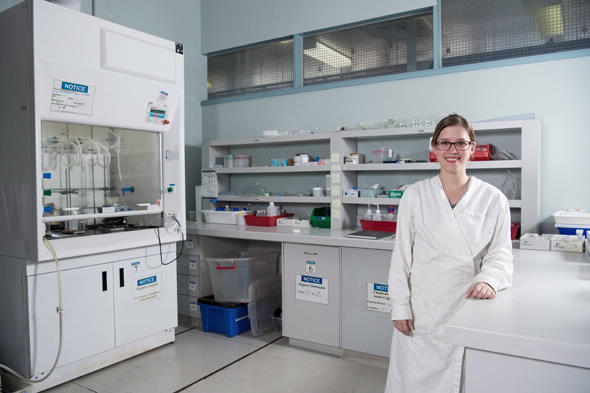
Radiochemical research is undertaken at ANSTO to develop advanced materials that have the capacity to separate target elements from complex, multi-element radioactive solutions created in the nuclear industry.
“Selective elemental separation is a challenging but important step in the context of environmental remediation, mining and industrial processing,” said materials researcher Jessica Veliscek-Carolan (pictured above).
Radiochemical separations have an added layer of complexity over traditional separations because of the presence of radiation.
In the nuclear industry, selective radiochemical separations are required to produce medical radioisotopes such as molybdenum-99.
They are also used to purify uranium ore in order to generate fuel and to process spent, irradiated nuclear fuel.
The focus of Veliscek-Carolan’s research is to treat solutions of spent nuclear fuel and recycle actinide elements, such as uranium, that can be re-used as fuel.
“Recycling of used nuclear fuel is of benefit both in terms of increasing the number of years that nuclear power could be a viable option for power generation, as well as decreasing the radiotoxicity, long half-lives and the volume of waste,” said Veliscek-Carolan.
By selectively separating the actinides, uranium, plutonium, americium, curium and neptunium, you could decrease the time required for waste to return to the safe radiotoxicity level of naturally occurring uranium from 130,000 years to 270 years.
Currently, most reprocessing of used nuclear fuel is performed using a liquid-liquid extraction process. However, the use of solid materials that can sorb radioactive elements has many advantages, such as avoiding the production of organic solvent wastes during processing.
Framework materials using titanium and zirconium have been developed because their radiolytic and hydrolytic stability should enable them to withstand the conditions of separations in extreme environments.
“Furthermore, these materials may be used as transmutation matrices or wasteforms once they are loaded with radionuclides,” explained Veliscek-Carolan.
In order to make these materials selective, the framework was first coated with organic ligands. The organic ligands used were chosen based on their selectivity for elements that occur in the nuclear fuel cycle.
Once it had been demonstrated that the organic coating on the titania nanoparticles was selective, more complex framework materials were developed to improve the sorption capacity and kinetics of the sorbent materials.For example, titania (TiO2) nanoparticles coated with amine and phosphate-based organic ligands, are able to selectively remove uranium from acidic solutions in the presence of caesium, strontium and the lanthanide elements; cerium, europium, and ytterbium.
Materials with high surface area are desirable to improve sorption capacity and an ordered pore structure was desireable to improve sorption kinetics.
“Extensive optimisation of synthesis conditions resulted in the production of a clean final product—ordered mesoporous titania powder,” said Veliscek-Carolan.
Optimised synthesis conditions were then used to produce millimetre-sized, spherical, hierarchically-porous beads that also demonstrated ordered mesoporosity.
 |
| Scanning electron microscopy image of porous titania bead |
The bead form is more practical than powder as it allows close packing of chromatographic columns during production with minimal clogging and high ease of handling.
Coating of the porous titania beads as well as titania nanoparticles with a modified version of a known organic ligand, bis-triazinyl-pyridine, produced materials that could selectively capture americium over europium.
“This is a highly challenging but essential separation for reducing the radiotoxicity and long half-life of nuclear waste,” said Veliscek-Carolan.
The experiment also confirmed that the beads sorbed more americium, that is, had a higher sorption capacity in a shorter period of time, demonstrating faster kinetics, than the nanoparticles.
Veliscek-Carolan collaborated with Tracey Hanley at ANSTO, Kate Joliffe from the University of Sydney and Vittoria Luca from CNEA on this research
Veliscek-Carolan was recently featured in a profile in the publication, the Ultimate Science Guide.
Published: 02/06/2016


